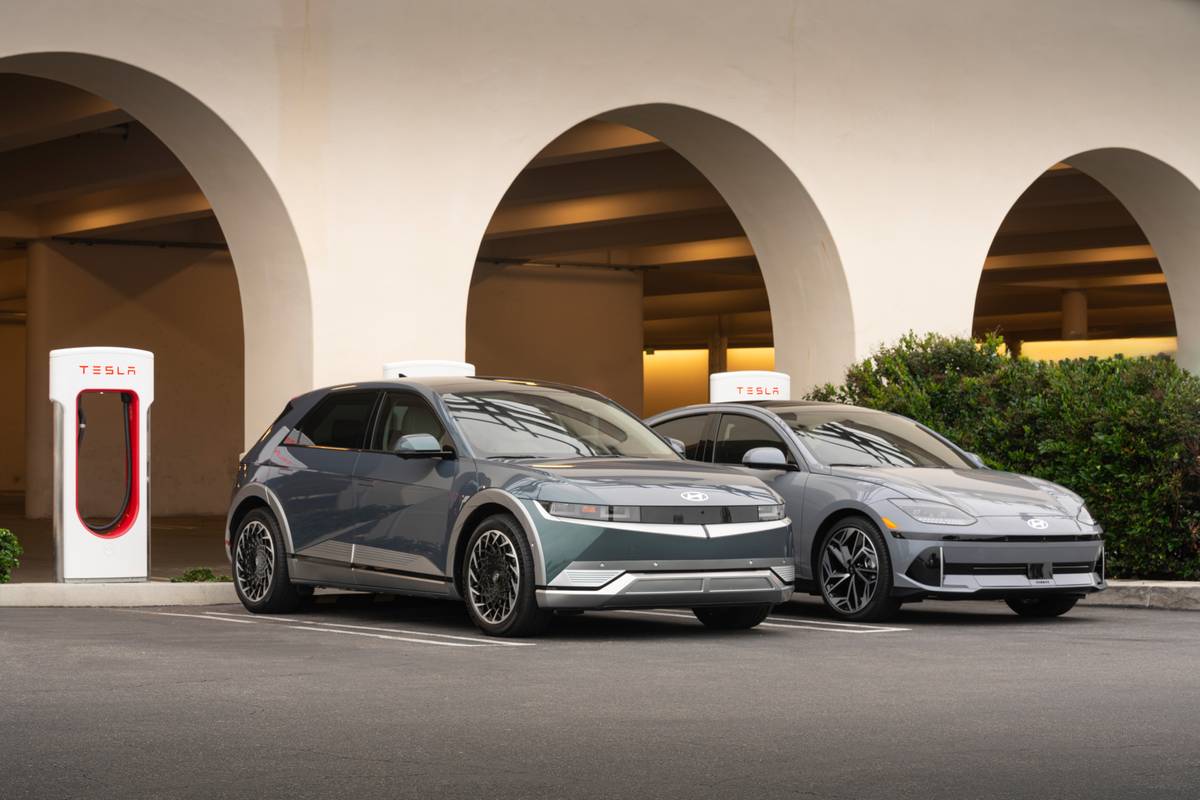Hyundai, Genesis, Kia to Adopt Tesla EV Charging Standard

Having already announced their participation in a massive joint venture to expand the public electric-vehicle charging network in the U.S., Hyundai and Kia — along with Hyundai’s luxury brand Genesis — are now granting owners of their EVs access to the largest fast-charging network in the U.S.: Tesla’s.
Related: When Will All Fast-Charging Stations Be Open to All EVs?
The South Koreans join more than 10 other brands from automakers including Ford, GM, Fisker, Rivian, Nissan, and Mercedes-Benz in forging a partnership with Tesla to allow their EVs to use Superchargers. The agreement follows the pattern established by Hyundai-Kia’s predecessors, albeit with details of timing shifted somewhat. Beginning in the fourth quarter of 2024, Hyundai, Kia and Genesis will install Tesla charging ports (the so-called North American Charging Standard) on their vehicles from the factory. Beginning in the first quarter of 2025, the brands will make adapters available to their customers, allowing those with the existing Combined Charging System charge port to use Tesla chargers.
A Critical Distinction
One word in the announcements from Hyundai and Genesis about this partnership signals a major difference from previous automakers’ agreements with Tesla: “exclusively.” Beginning in the first quarter of 2024, the South Korean brands’ EVs “will come exclusively with a NACS port,” meaning the companies will abandon the CCS charge port and fit their vehicles only with the Tesla NACS port.
As our national charging infrastructure has developed, CCS and NACS have emerged as the two primary charging standards, and their incompatibility has resulted in a situation akin to BP and Shell using different fuel nozzles that force drivers of gas cars to only use one chain or the other. Adapters allowing conversion from NACS to CCS and vice versa are one solution, but everyone agreeing to one type from the factory streamlines things — and the NACS plug is much smaller and lighter than the CCS.
Charging Speed Matters
All of this is important because it comes down to charging speed. There are (so far) three types of EV charging. Level 1 charging works off a household 120-volt electrical outlet and is perhaps best reserved for emergencies only, as it can only charge an EV’s massive battery at a rate that provides for a few miles of range per hour. Level 2 charging uses a 240-volt outlet like a central air conditioner or clothes dryer. This is what a typical home charging station uses, but it still requires many hours to fully charge an EV battery.
DC fast charging offers the sort of recharge necessary to make long-distance EV travel a reality. While there are currently about 118,000 public Level 2 charging stations in the U.S. today, according to the Department of Energy, there are far fewer DC fast chargers — and most of them are Tesla Superchargers. While that global joint venture looks to expand the fast-charging network farther in the future, partnerships like the one between Hyundai-Kia and Tesla will have a more immediate near-term payoff for buyers of the automakers’ electric cars.
More From Cars.com:
- Hyundai Offers EV Customers Home Charger Deal
- Home EV Chargers and How to Choose One
- J.D. Power Study Finds EV Owners’ Satisfaction With Public Charging Slipping
- EV 101: A Video Guide to Electric Vehicles
- How Much Do Electric Car Charging Stations Cost?
Related Video:
Cars.com’s Editorial department is your source for automotive news and reviews. In line with Cars.com’s long-standing ethics policy, editors and reviewers don’t accept gifts or free trips from automakers. The Editorial department is independent of Cars.com’s advertising, sales and sponsored content departments.
Featured stories




